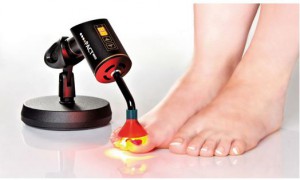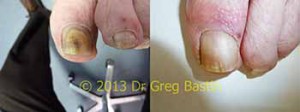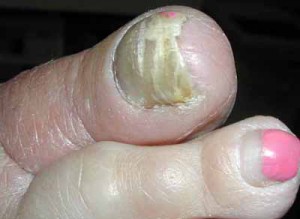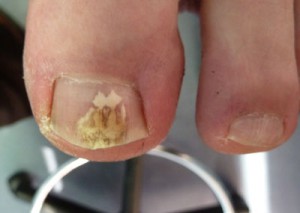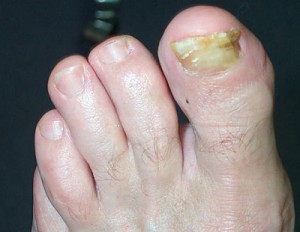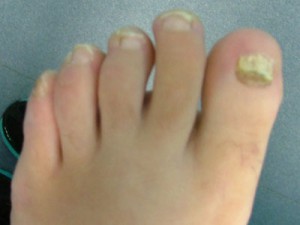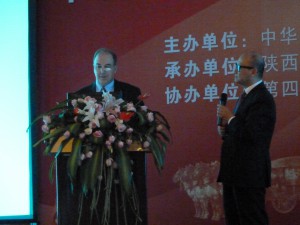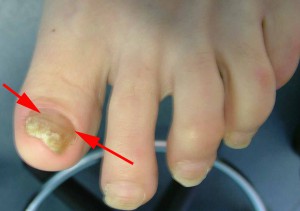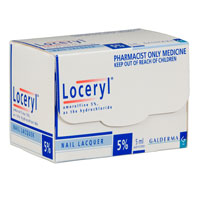Nail Fungus Treatment with PACT
Nail Fungus can now be treated with PACT Nail Fungus Treatment this is a photodynamic light therapy, it involves applying a sensitizing agent to the nail this agent stains the fungal elements and sensitizes them to the light that is used by PACT. a light is then shone on the nail for approximately 10 minutes. This when repeated several times on the nail will destroy the nail fungus. There is NO heat generated by this system unlike hot lasers often used to treat nail fungus, however the main draw back is the time for this treatment it takes just over one and a half hours to treat 10 nails and this needs to be done several times a week. This makes this therapy very time consuming for the patient. We feel that is certainly has a place in the treatment of nail fungus especially if only one nail is involved, however it is not worth treating 10 nails as the time to accomplish the treatment is just too great.
PACT Nail Fungus Treatment
Brighton Podiatry was the first Podiatrist in Melbourne to use Laser to treat nail fungus. Prior to this we were using a combination of Oral medications and Surgical removal of nails. We have been using Laser to eradicate unsightly nail fungus for 7 years now. Dr Greg Bastin has made numerous trips overseas to conferences and to attend workshops on the use of laser. Unlike most other clinics using Laser in Melbourne we have several different types of lasers. We will assess your toenail fungus and come up with a treatment plan that is tailored to the individual patient.
Patients must understand that nail fungus is incredibly resilient to treatment and there is NO treatment that is 100% successful Dr Bastin says that in my 20 odd years of practice as a Podiatrist this treatment offers suffers of nail fungus the best chance of eliminating the ugly appearance of nails that are infected with fungus.
If you suffer from nail fungus give us a call at Brighton Podiatry and schedule an appointment to see how we can help you beat Nail Fungus.
Nail Fungus Before Laser Treatment and 9 months post treatment
Toenail Fungus Laser
Nail Fungus is an unsightly condition where fungus infects the toe nail plate and progressively over time discolours and destroys the toe nail. Currently we see an enormous amount of these infections as a result of visits to nail salons which use no form of sterilisation resulting in the cross contamination of clients. Nail fungus is inherently difficult to get rid of as the organism causing the infection is extremely resilient to treatment. There are a number of topical paints on the market, however we have found these to be of little use. Topical medications can be used to destroy the fungus at the nail cells we find that this will give cure rates in the order of 40% but one must be comfortable with the side effects caused by this medication.
Terbinafine – a question of taste
Terbinafine (Lamisil) is a new antifungal drug with activity against infections due to dermatophytes (e.g. “ringworm”) and Candida albicans. It was first marketed in Australia in late 1993 and since that time ADRAC has received 168 reports documenting a total of 323 suspected adverse reactions to terbinafine, and these are grouped in the figure below. ADRAC is concerned by the number and nature of these reports, considering that the drug is often used for minor conditions and for a prolonged period.
There are two prominent groups of adverse reactions. Those reactions involving the gastrointestinal tract (GIT) (87 reports) include nausea (14 cases), abdominal pain (8), mouth ulceration (5), and in particular, taste perversion or loss which is described in 29 reports. In many of these cases, the taste disturbance had not recovered at the time the report was submitted (21 cases). Reports involving the skin (106 reactions) include many eruptions suggestive of hypersensitivity or photosensitivity: the reactions described include a variety of rashes, urticaria, erythema multiforme and eczema.
Other serious adverse drug reactions including blood dyscrasias (especially affecting white cells) have been the subject of concern in some other countries, and to date ADRAC has received 2 reports describing suspected neutropenia (both recovered) and 1 case of agranulocytosis (not recovered at the time of the report). Finally, there are 11 adverse hepatic reactions involving 5 reports of abnormal hepatic function, 4 reports of jaundice and 2 reports of hepatitis. While all the above reactions are mentioned in the product information, the potentially wide usage of terbinafine has prompted this early overview in order to encourage careful prescribing and close monitoring of its adverse effects.
http://www.tga.gov.au/hp/aadrb-9602.htm#terbinafine
Toenail Fungus Laser in Melbourne
At Brighton Podiatry we use laser as an antifungal treatment the results are outstanding. Brighton Podiatry was the first Podiatrist to adopt this toenail fungus laser technology in Melbourne and we are only one of a few Podiatrists world wide who have used 4 different laser systems in the treatment of nail fungus. We know what will give patients the best results and we always strive for the best result for all our patients. If you suffer from toe nail fungus give the clinic a call and schedule an appointment.
Recently Dr Greg Bastin was invited to speak about the Treatment of Onychomycosis at the 17th Annual Dermatology meeting in Xian China. (第十七届全国皮肤性病学会年会)
Dr Bastin has been using this protocol for around 10 months with excellent success rates to date.
There is a growing interest in this technology worldwide as Onychomycosis effects large numbers of people worldwide.
There was an enormous interest in China as indicated by the number of questions from Dermatologists attending this meeting from all over China.
If you have problems with this condition please give the clinic a call to schedule an appointment. We will assess your nail infection to see whether this treatment may help you.
This patient presented with onychomycosis (fungal infection) to the left hallux (big-toe). She is a 45 year old female who states that she has had fungus in this nail for at least 5 years. She further states that she has used Loceryl on it for over a year with no noticeable change to the toenail fungus. She has also tried tea tree oil, vicks vaporub, listerine on it. All of these made no difference. 18 months ago in despiration she had the nail surgically removed, she found this very unpleasant and extremely painful. She states that from about 8 weeks the nail started regrowing and she noticed that the fungus was back. It took around 11 months for the nail to fully regrow and she was very disappointed with the result.
She came to me very sceptical about laser, we discussed the likelihood of resolution was around 80% but there were no guarantees made. After thinking about it for 2 weeks she finally decided to give it a try and she also said if this fails she would “give up”.
We treated her nail with laser, she states that there was a little pain but nothing like what she had been through with this problem.
4 Weeks later we did a second laser session which she found fine. We made an appointment 3 months later for follow up.
At 3 months after the second treatment I could see the nail was definitely growing out “clear at the root”, the patient was also very pleased with the result.
We will continue to follow up as 3 month intervals.
Very Rarely (<1/10000) burning sensation and contact dermatitis.
Clinically we do not see cure rates anywhere near the claims that the manafacturers of Loceryl make although it must work for some.
At best the result may be 2 to 3 % on nails with serious fungal infections, it might be more successful on nails with superficial white Onychomycosis but then would you bother paying for Loceryl when you can use some emery paper and simply sand the fungus off the nail.
Loceryl has an active ingredient called Amorolfine
It does not seem as effective on nails with deep nail fungal infections or nails where the nail matrix is involved.
We have seen several patients that have used Loceryl for a few years with no result. I guess there must be some patients that have varying forms of success. Some patients have purchased several boxes at a cost of between $ 75 to $80, resulting in them spending several hundred dollars with little or no results.
On the upside there are no major issues with loceryl as far as side effects, so what is onychomycosis ?
It is a fungal infection of the nail plate brought about by one or more of the following organisms:
Trichophyton rubrum is the most common dermatophyte involved in onychomycosis. Other dermatophytes that may be involved are Trichophyton mentagrophytes Trichophyton interdigitale, Epidermophyton floccosum, Trichophyton violaceum, Microsporum gypseum, Trichophyton tonsurans, Trichophyton soudanense various yeasts and moulds.
So should you try Loceryl well we will leave that descision up to you.
Prescription Medication for Toenail Fungus
Fungal nail infections are notoriously difficult to treat. Unfortunately, while early treatment is the most effective, most people don’t recognize or look for the early symptoms. By the time they experience enough discomfort to prompt a trip to the doctor, the nail infection often has passed the mild stage and moved into the territory where it has become difficult to treat. There are a variety of toenail fungus medications available with a variety of success rates and side effects.
When a doctor selects a type of toenail fungus medication to treat an infection, he has two types of drugs to choose from: oral prescription medications and topical prescription treatments. The problem with both is that the toenail fungus cure rate is low and the side effects can be serious. Here’s a look at the medications currently being prescribed to treat fungal nail infections.
Oral Toenail Fungus Medications
There are three oral nail fungus medications on the market. Two of these drugs (Lamisil and Sporanox) are approved by the FDA to treat fungal nail infections. The other drug (Diflucan) is FDA approved to treat other conditions, but not approved to specifically treat a fungal nail infection. All of the oral medications prescribed for a nail fungus infection have significant side effects, the most serious of which is potential liver damage. Everyone who takes these prescriptions must be monitored for liver and blood cell function on a regular basis. These drugs as a whole have a less than 50% percent cure rate.
1. Lamisil (Terbinafin)

Of the three oral antifungal medications, FDA approved Lamisil seems to have the best cure rate for treating dermatophytes, the common fungus responsible for nail fungal infections, but it has also the most severe side effects. This medication works by inhibiting the enzyme responsible for allowing the fungus to growth. Prescribed in 250 mg doses, it is taken for at least six weeks for fingernail fungal infections and a minimum of twelve weeks for toe nail fungal infections.
The most common side effects experienced while taking Lamisil include gastrointestinal problems such as:
- Diarrhea
- Abdominal pain
- Indigestion
Of even greater concern is the damage that it can cause to the liver. It is suspected to have caused such severe liver damage in some patients that they required a liver transplant or even died. Patients who take Lamisil are advised to watch for liver damage symptoms such as:
- Jaundice
- Nausea
- Loss of appetite
- Taste disturbance
- Stomach pain
- Itching
- Dark urine
- Clay-colored stools
Of those who are able to take Lamisil almost half report a cure.
In addition to side effects, Lamisil can interact with other common drugs such as tricyclic antidepressants, selective serotonin reuptake inhibitors, beta-blockers and monoamine oxidase inhibitors Type B. Anyone that is pregnant or suffers from kidney disease or immune system deficiencies should not take Lamisil.
2. Sporanox (Itraconazole)

Sporanox or Itraconazle is used to treat yeast and fungal infections including fungal infections of the mouth (thrush), esophagus (esophageal candidiasis), lungs (aspergillosis), and nails. This oral prescription drug is FDA approved and works by killing the fungus and inhibiting its growth. Doses vary with the individual and the seriousness of the infection.
The most common side effects for this nail fungus medication include:
- Nausea or vomiting
- Diarrhea
- High blood pressure (hypertension)
- Convulsions
- Fever
- Irregular heartbeat
- Shortness of breath
- Increased thirst
- Dark urine
- Loss of appetite
- Mood changes
- Muscle pain or cramps
- Numbness or tingling in the hands, feet, or lips
- Unusual tiredness or weakness
3. Diflucan (Fluconazole)

Diflucan is a medication that is used to treat a variety of fungal yeast infections but it has not been approved by the FDA to treat nail fungal infections. It is commonly used to treat Candida yeast infections such as vaginal yeast infections, urinary tract yeast infections, peritonitis, pneumonia and cyptococcal meningitis.
Side effects are less severe with Diflucan than either Lamisil or Sporanox, but it is also less effective used as a nail fungus medication. Some of the side effects include:
- Nausea
- Diarrhea
- Stomach pain
- Headache
- Dizziness
- Hair Loss
- Temporary hepatic (liver) reactions
Topical Toenail Fungus Medications
There are several prescription topical antifungal medications that are prescribed for the treatment of a fungal nail infection. Unfortunately, they have a very low success toenail cure rate and are most likely to produce a cure when used in the very earliest stages of the infection. As the condition worsens, topical nail fungus medications are less effective and even they have side effects.
1. Penlac (Ciclopirox) Nail Lacquer
 Penlac is an antifungal medication used to stop the growth of fungus. As a cream it is used to treat athlete’s foot, ringworm, jock itch and minor fungal infections of the nail. Penlac Nail lacquer is brushed on to the surface area of the affected nail, the underside of the nail and the skin beneath the nail. It should be left on for eight hours before showering. The most common side effects include burning and itching at the site. Cure rates range from 9% to 36%.
Penlac is an antifungal medication used to stop the growth of fungus. As a cream it is used to treat athlete’s foot, ringworm, jock itch and minor fungal infections of the nail. Penlac Nail lacquer is brushed on to the surface area of the affected nail, the underside of the nail and the skin beneath the nail. It should be left on for eight hours before showering. The most common side effects include burning and itching at the site. Cure rates range from 9% to 36%.
2. Loceryl (Amorolfine) Nail Lacquer
Loceryl has not yet been approved by the FDA. In mild cases Loceryl has been shown to have a 40% cure rate, but in more severe cases the cure rate falls off dramatically. It is applied by brush once or twice a week to the infected nail area for up to six months. Like Penlac, the side effects of Loceryl are localized to the site and include burning, itching, scaling and dry skin.
Conclusion & Recommendation
In conclusion, the prescription nail fungus medications on the market have a low cure rate and are fraught with side effects. The oral prescription medications present the most concern to the user with the serious risk of long term damage to the liver. It is important to consider all of the risks before taking any nail fungus drug.
From among all the treatments covered by our study, two natural remedies met our requirements and achieved a high success rate. These products, Zetaclear and Funginix, are free of side effects, very effective for most people, and affordable. Both are approved by the FDA. Click here to learn how these toenail fungus treatments can help you.
from: toenailfungustreatmentreview.com/toenailfungusmedication.html
We recommend the use of Loceryl on Superficial white Onychomycosis, however it doesnt appear to be that effective on deeper nail fungus.

A promising new laser treatment may eliminate toenail fungus.
Everyone wants to put their best foot forward, but people with toenail fungus go to great lengths to keep their feet under wraps.
A promising new laser treatment may eliminate toenail fungus.(ABC News Photo Illustration)
Meghan Rafferty, a 36-year-old from New York City, is one of millions of Americans who lives with toe fungus.
Looking at her toenails, Rafferty said, “It’s discolored, it’s yellow. It’s thick. Um, it’s crooked, it just looks, it looks dead, like dead nails.”
Not only is toe fungus ugly and embarrassing, it’s also easy to catch, as it thrives in wet environments such as nail salons and locker rooms. And people will do just about anything to hide it. Podiatrist Paul Greenberg said he has female patients who say their husbands haven’t seen their feet in 25 years.
“In yoga, I would be embarrassed,” Rafferty said. “I go to the nail salon, and just like they put tips on your fingernails, I would get tips on my toenails.”
Once the fungus gets under a toenail, it’s difficult to treat. Topical solutions don’t always work and oral medications carry a risk of side effects and can be hard on the body.
Rafferty is trying a promising new laser procedure to treat toenail fungus.
“The laser beam travels through the nail to the level of the nail fungus and kills the fungus instantly,” said Gary Evans, a New York City podiatrist.
The Food and Drug Administration cleared the use of PathoLase Inc.’s PinPointe FootLaser system, which has been available in the United States since September 2008. Evans has been using it for a few months and says it’s exciting because it’s painless and side-effect free.
As Evans moved the laser over the nail, Rafferty said she didn’t feel anything.
“We have to go in certain patterns to make sure we get every little millimeter of the nail plate,” Evans said.
The procedure takes less than a half hour and, while results aren’t immediate, the toenail will grow out normally in nine to 12 months, in most cases.
PathoLase said its laser is 88 percent effective, which it claims is better than anything else on the market.
Fungus-free feet will cost you, though. The treatment goes for about $1,200 and isn’t covered by insurance.
Rafferty is willing to pay for normal-looking toes. “I’m just really excited to see what the results are. This is fantastic,” she said.
PinPointe FootLaser Receives FDA Clearance
PinPointe FootLaser Receives FDA Clearance for the Treatment of Nail Fungus (Onychomycosis).
Offers New Treatment Option for More Than 35 Million Americans with the Condition
CHICO, CA – October 20, 2010 – PinPointe USA, Inc., a leader in podiatric light-based therapy, announced today the PinPointe™ FootLaser™ received clearance from the U.S. Food and Drug Administration (FDA) for the treatment of nail fungus (onychomycosis). During the procedure, which is administered by podiatrists, a specially-designed laser beam is directed across the nail. The laser penetrates the nail bed targeting the fungi responsible for the infection, while leaving the nail and surrounding healthy tissue intact.
Fungal nail infection is estimated to affect more than 10 percent of the U.S. population – or 35 million Americans. This condition is caused by fungus under the nail. As they grow, fungi feed on keratin, the tough protein that makes up the hard surface of the nails. The nail becomes darker in color and debris may accumulate under the nail. And the infection may spread to other toenails, the skin or the fingernails. Nail infection can cause nails to be discolored, thickened, brittle, and ‘crumbly’ and in some people it can interfere with wearing shoes and/or cause pain when walking.
“Toenail fungus is an incredibly embarrassing chronic condition affecting millions of people worldwide that genuinely impacts a person’s quality of life. For some with diabetes or immune disorders nail fungus can lead to serious health problems,” said Dr. Adam Landsman, Assistant Professor of Surgery at Harvard Medical School and Chief of the Division of Podiatric Surgery at Cambridge Hospital in Massachusetts. “With the clearance of the PinPointe FootLaser, patients finally have a pain-free treatment option that is more successful than topically-applied antifungal drugs, safer than oral medication, and less painful than surgical removal of the nail.”
The treatment of nail infection is difficult because the infection is under and inside of the nail. This makes it hard for any treatment to reach and destroy the infection. Some people are treated with medicated nail polish or oral medications, which can be associated with side effects and serious drug interactions. Another option is to surgically remove the nail. Many people also try bleach, vinegar, mouthwash or household cleaners – home remedies that ultimately do not resolve the problem.
“PinPointe submitted clinical evidence to FDA demonstrating that after a single treatment, between 68 percent and 81 percent of patients experienced increased clear nail at six and 12 months and 81 percent of all patients had sustained improvement at 12 months. Now, a single 30 minute treatment can be done comfortably in the privacy of a doctor’s office without the need of anesthesia,” says John Strisower, founder and Chief Executive Officer of PinPointe. “Our goal is continued market leadership of podiatric light-based therapeutic technology.”
The PinPointe FootLaser is also sold in the European Union under a CE Mark for the treatment of nail fungus, and is TGA-approved and available in Australia and New Zealand.
